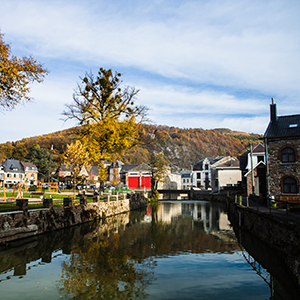Mont
Introduction
 The village of Mont is interesting for more than one reason: it is of aesthetic interest in terms of the landscape and also of geographic, botanical, hydroecological and potholing interest. These different assets make it a prime venue for sports, social events and educational activities.
The village of Mont is interesting for more than one reason: it is of aesthetic interest in terms of the landscape and also of geographic, botanical, hydroecological and potholing interest. These different assets make it a prime venue for sports, social events and educational activities.
With respect to potholing, there are a large number of sinkholes, losses, dolines and caves forming an enigmatic underground world.
Overlooking the Meuse Valley, above Godinne, the village extends over the hillside along two main streets with a few secondary streets running perpendicularly to them. The housing is relatively well-spaced, except perhaps in the central street, and comprises 19th-century houses built with sandstone masonry combined with limestone, sometimes with whitewash. These are concentrated in the streets "Sous les Sources" and "Sous le bois".
Housing expanded massively in the late 20th century with the expansion of the Mont-Godinne university clinics, located on the top of a cliff overlooking the Meuse, to the west.
Potholing
There are several caves and underground passages, including the Trou Bernard.
Contact: http://www.speleo.be/
History and Heritage
Mont is a major Neolithic site. It includes several caves which have yielded human and animal bones and an array of flint artefacts. The cave of Chauveau has been known to specialists since the 14th century. It is linked to early anthropological developments and prehistoric archeology in Belgium.
Under the old regime, Mont was a part of Godinne. The village of Mont formed part of the high estate of Godinne and Rivière, cut off from the rest of the Estate by Archdukes Albert and Isabelle on 11 July 1612 and committed to François de Maillen. This land was transferred with Godinne to the Wahas (1638), the Orjos (1643) and the Moniots (1721), ironsmiths whose "factories" were located on the hillsides overlooking the Meuse Valley. It remained their property until the end of the Old Regime.
Unsatisfied with his Rivière forges, Hendrick d’Harscamp acquired a property formerly called "Chauveau". under the jurisdiction of Godinne This property had a stream running through it, which came out of a rock belonging to him. At the behest of the archdukes, under a decree issued on 14 June 1619, Hendrick was authorised, in exchange for an annual fee, to erect a "cannon mill" on this property . Once he had embarked on this route, he greatly expanded this business. These documents are sufficient to establish the fact that Hendrick, sometimes alone, sometimes with his partners, gave industry in Namur an unprecedented spurt of growth. The arrival of weapons manufacturing in our province can even be attributed to him, as the grant of 14 June 1619 given to him to this end is one of the oldest known.
The hamlet of Mont was separated from Godinne in 1865 to be established as a distinct municipality.
On 4 January 1965, Mont was once again merged with Godinne (a voluntary merger to be known as Mont-Godinne).
Heritage
- The Trou Wéron
- Trou de l’Eglise
- Trou de Bernard
- Trou du Ry
- Saint Charles Borromée Parish Church
- Originally, the clinic was the Mont-Sur-Meuse sanatorium, also known as the Institut Thérasse. At the turn of the century it fulfilled all of the requirements for an institute of this nature. The sanatorium was built in 1903. The nuns from the Congregation carried out nursing duties. The Mutualités Chrétiennes (for whom tuberculosis was a major concern at that time) added a ward in 1926.
- 18th and 19th-century houses
- Presbytery, shrines and 3 Statues of Christ on the cross
- Unenclosed U-shaped farm



